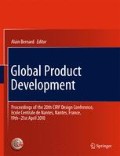Abstract
Product development was deeply modified by globalisation. New practises to ease remote collaborative work are expected. Many methods and tools were developed for this objective in a fragmented vision depending of the usage contexts. The computer supported cooperative work (CSCW) community defined tools dedicated to generic collaboration without specialisation about a specific business. Under this classification, whiteboards are dedicated to synchronous remote work around unstructured sketches. On another point of view the design community developed new shared models for structured information about the product. This chapter proposes the integration of both in order to create whiteboards dedicated to technical business activities.
Access this chapter
Tax calculation will be finalised at checkout
Purchases are for personal use only
References
Johansen, R. (1988) Groupware: Computer Support for Business Teams. The Free Press, New York, NY.
Rupp, T.M., Steiner, C.P. (2003) Supporting distributed engineering in the aerospace industry by web-based collaborative applications, in ICE2003. Proceedings of the 9th International Conference on Concurrent Enterprising, Espoo, pp. 509–517.
Riechelmann, E., Zollner, R., Vollerhun, A. (2004) Process optimization and innovative work environment for concurrent engineering: case studies in the aero engines industry. 1st International Conference on Virtual Design and Automation, Poznan, Poland.
Ruiz-Dominguez, G.A., Boujut, J-F., Diallo, T. (2004) On the sequential effect induced by the use of communication tools in distant collaboration. Proceedings of the TMCE 2004, Lausanne, Switzerland, pp. 953–964.
Mechekour, E-H., Marin, P. Masclet, C. (2006) Which tool to better support collaborative design?. 6th International Conference on Integrated Design and Manufacturing in Mechanical Engineering, Grenoble.
Scriblink, http://www.scriblink.com/. Last visited October 5th 2009.
Groupboard, http://www.groupboard.com. Last visited October 5th 2009.
Twiddla, http://www.twiddla.com/. Last visited October 5th 2009.
Dabbleboard, http://www.dabbleboard.com. Last visited October 5th 2009.
Marin, P., Gerbaud, L., Mechekour, E-H., Masclet, C. (2007) An observational study of multi-disciplinary co-design – application to an electromechanical device. Journal of Design Research, 6(3):311–332.
Törlind, P., Larsson, A. (2002) Support for informal communication in distributed engineering design teams. International CIRP Design Seminar, 16–18 May, Hong-Kong.
Hisarciklilar, O. (2008) Formes et structures des annotations sémantiques pour supporter la communication en conception collaborative asynchrone, PhD dissertation, Industrial Engineering, Grenoble University, November 28th.
Hanser, D. (2003) Proposition d’un modèle d’auto coordination en situation de conception, application au domaine du bâtiment, PhD dissertation, Architecture sciences, INP Lorraine, October 31st.
Tichkiewitch, S. (1994) De la CFAO à la conception intégrée. International Journal of CADCAM and Computer Graphics, 9(5):609–621.
Roucoules, L., Tichkiewitch S., (2000) CODE: A cooperative design environment – a new generation of CAD systems. Concurrent Engineering: Research and Applications, 8(4):263–280, ISSN 1063-293X.
Standard For The Exchange of Product Model Data (STEP) (1994) ISO 10303, A series of documents. Part 42: Geometric and Topological Representation, ISO 10303-42. Available from ISO Secretariat, National Institute Of Standards and Technology (NIST), Gaithersburg, MD.
Urban, S.D., Ayyaswamy, K., Fu, L., Shah, J.J., Liang L. (1999) Integrated product data environment: data sharing across diverse engineering applications. International Journal of Computer Integrated Manufacturing, 12(6):525–540.
Claus, R., Kazakov, M. (2007) OMG CAD Services V1.0 standard: an approach to CAD–CAx integration. International Journal of Product Lifecycle Management 2007. 2(2):157–172.
Gero, J.S., Kannengiesser, U. (2004) The situated function behaviour structure framework. Design Studies, 25:373–391.
Noël, F., Roucoules, L. (2008) The PPO design model with respect to digital enterprise technologies among product life cycle. International Journal of Computer Integrated Manufacturing, 21(2):139–145.
Sudarsan, R., Fenves, S.J., Sriram, R.D., Wang, F. (2005) A product information modeling framework for product lifecycle management. Computer-Aided Design, 37(13):1399–1411.
Gupta, R.K., Gurumoorthy, B., (2008) A feature-based framework for semantic interoperability of product models. Journal of Mechanical Engineering, 54:109–112.
SYSML, http://www.sysml.org/ visited on November 2009.
Delinchant, B., Riboulet, V., Gerbaud, L., Marin, P., Noël, F., Wurtz, F. (2002) E-cooperative design among mechanical and electrical engineers: implications for communication between various professional cultures. IEEE Transactions on Professional Communication, 45(4): 231–249.
Mer, S. (1998) Les Mondes et les Outils de la Conception, pour une Approche socio-technique de la Conception de Produit, PhD thesis, INPG.
Mechekour, E-H. (2006) Etude des aspects informels en conception collaborative à distance; Propositions pour des outils supports aux activités synchrones, Ph.D. dissertation, Grenoble INP, Grenoble, France.
Tichkiewitch, S., Chapa Kasusky E. (1997) Méthodes et outils pour l’intégration et la conception holonique. International Journal of CADCAM and Computer Graphics, 12(6, 12):647–667.
Krause, F-L., Kieswetter, T., Kramer, S. (1994) Distributed product design. Annals of the CIRP, 43(1):149–152.
Author information
Authors and Affiliations
Corresponding author
Editor information
Editors and Affiliations
Rights and permissions
Copyright information
© 2011 Springer-Verlag Berlin Heidelberg
About this paper
Cite this paper
Vu-Thi, H., Marin, P., Noël, F. (2011). Integrating Product Model and Whiteboard to Ease Collaborative Work in Global Product Development. In: Bernard, A. (eds) Global Product Development. Springer, Berlin, Heidelberg. https://doi.org/10.1007/978-3-642-15973-2_21
Download citation
DOI: https://doi.org/10.1007/978-3-642-15973-2_21
Published:
Publisher Name: Springer, Berlin, Heidelberg
Print ISBN: 978-3-642-15972-5
Online ISBN: 978-3-642-15973-2
eBook Packages: EngineeringEngineering (R0)

